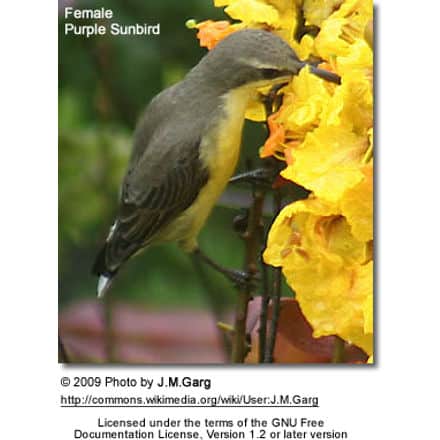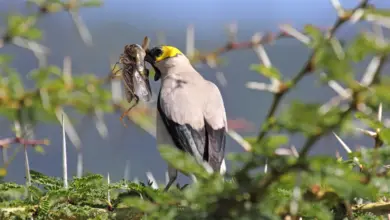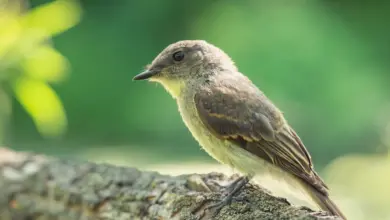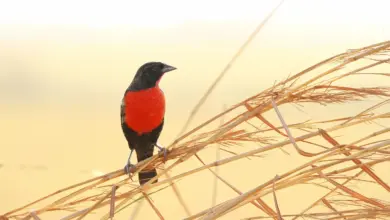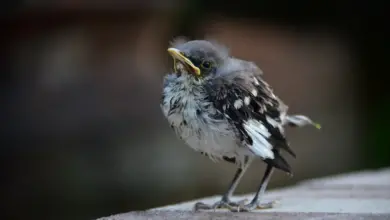Purple Sunbirds
The Purple Sunbirds (Cinnyris asiaticus) are small, nectar-feeding birds that belong to the sunbird family.
Their extensive natural range stretches from West Asia through the Indian Subcontinent and into Southeast Asia.
They share many similarities with the New World (“Americas”) hummingbirds, as they are also able to hover in front of flowers to retrieve nectar.
They are usually seen in pairs or small (family) groups, except at favored feeding sites where up to 40 to 50 of them can be found.
Captive sunbirds have been reported to live nearly 22 years.
Hummingbird Resources
- Hummingbird Information
- Hummingbird Amazing Facts
- Attracting Hummingbirds to Your Garden
- Hummingbird Species
- Feeding Hummingbirds
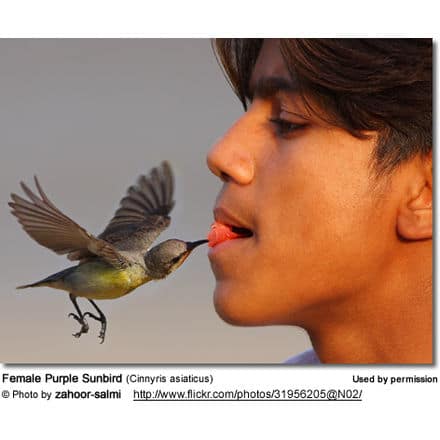
Distribution / Habitat
Purple Sunbirds are mostly resident (non-migratory) and are distributed from sub-Saharan tropical Africa, the eastern tip of the Arabian Peninsula through the Indian sub-continent and into Southeast Asia.
Short-distance / local movements (particularly in the drier areas of northwestern India and Pakistan) and altitudinal migration pattern have been noted in some parts of their range – most likely as they follow the flowering seasons of their favorite feeding flowers.
They mostly live in plains, but may move up to 5,600 feet (~1,700 meters) in the Himalayas and up to 7,900 feet (~ 2,400 meters) in southern India.
They inhabit thin forests, but are also found in gardens and even in dense urban areas, where they are usually observed near flowering shrubs and trees.
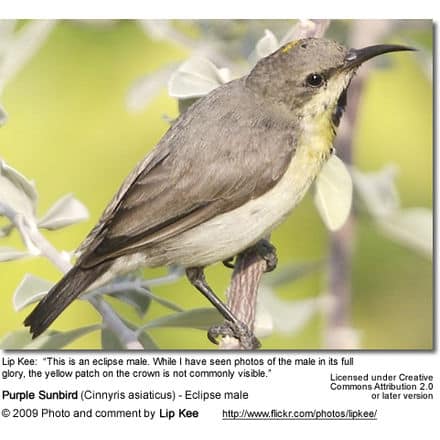
Subspecies and Ranges:
- Indian Purple Sunbird (Cinnyris asiaticus asiaticus – Latham, 1790) – Nominate form
- Range: India east of the desert region and south of the Himalayas extending to the west and south of India and Sri Lanka.
- Short-billed Purple Sunbird (Cinnyris asiaticus brevirostris – Blanford, 1873)
- Range: Eastern Arabian Peninsula, including northern United Arab Emirates, northern and central Oman), as well as southeastern Iran, eastern Afghanistan, Pakistan and western India (western regions of Rajasthan and Gujarat).Occur in the dry zone of the west from the eastern Arabian Peninsula into southeastern Iran, eastern Afghanistan, Pakistan until the dry zone (western regions) of Rajasthan and Gujarat.ID: Their yellow pectoral tufts (“arm pits”) have a slight tinge of green.
- Long-billed Purple Sunbird (Cinnyris asiaticus intermedius – Hume, 1870)
- Range: East India, from Assam south to the border of Orissa and northern Andra Pradesh) northwards into Bangladesh east to Myanmar, southern China (southern Yunnan) and Indochina.
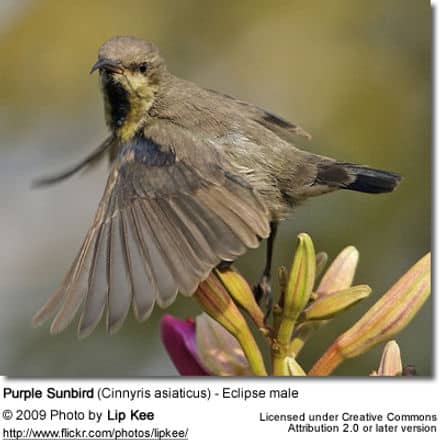
Description
Size
Purple Sunbirds measure up to 4 inches (10 cm) in length, including the tail.
Males
The adult breeding male has a plumage that may appear all black (particular in low light) or dark metallic blue or purplish-black – depending on the light conditions. The wings are dark brown. During courtship displays, breeding males will flash their yellow pectoral tufts (“arm pits”), which are otherwise hidden. They have bright blue shoulder patches and an iridescent maroon collar around the neck.
The eclipse (non-breeding) male has a pale olive brown or yellow-grey upper plumage, except for blackish wings and tail. The chest and abdomen are yellow with a blue central streak extending from the throat to the abdomen. Males in the eclipse plumage were formerly separated as species currucaria.
Females
Females are yellow-grey to olive brown above and yellowish below. The throat and chest are yellow turning paler towards the vent. She has a faint yellow supercilium (line above eye). Her black tail has a narrow white tip.
Other Physical Details
- Medium-length, thin, down-curved bill with a brush-tipped tubular tongue that enable them to reach into deep flowers to collect nectar.
- Dark, short, square ended tail tipped in white.
- Relatively short wings. Their flight is fast and direct
Similar Species
Breeding males resemble Loten’s or Long-billed Sunbirds (Cinnyris lotenius); which can most easily be identified by the longer bill and distinctive broad maroon chest band.
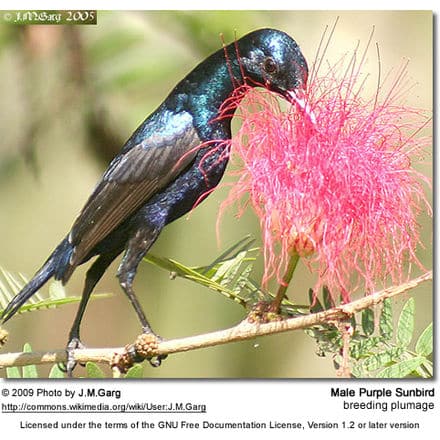
Diet / Feeding
Purple Sunbirds mostly feed on nectar – occasionally hovering in front of the flowers like a hummingbird, but generally, they prefer to perch in front of them to retrieve the nectar.
Some native plant species – such as Butea monosperma, Acacia, Woodfordia and Dendrophthoe – are dependent on them for pollination and would not be able to exist without the “services” inadvertently rendered by these birds. In the process of feeding, flowers benefit from cross-pollination as the head becomes covered with pollen and spreads from flower to flower. As these birds move to the next flower, the pollen is deposited on the next flower, which is then able to produce seeds and fruit.
To a lesser extent, they also eat fruits, small berries and cultivated grapes.
To varying degrees, they will also feed on small insects and spiders, particularly when raising young. Insects are usually captured in mid-air.
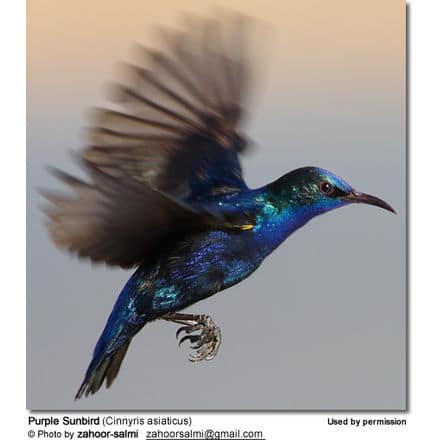
Breeding / Nesting
Purple Sunbords usually breed before the onset of the Monsoon (rainy) season, which varies by region. In northern India, it is from April to June and in Sri Lanka from January to June.
The male performs a courtship display, which involves raising his head, fanning his tail and fluttering with partly open wings to expose his pectoral tufts (“arm pits”) while singing to the female.
The nest is constructed almost entirely by the female within a 5 – 10 day period. The pouch-shaped nest is made out of unwoven, thin strips of vegetation, lichens and bark, and held together with cobwebs. The entrance is on the side, often with an overhanging projection. The nest is typically suspended from a low branch, but at times are attached to man-made objects, such as wires. The inner cavity is expanded by the bird opening its wings and turning around inside.
A clutch consists of 1 – 3 eggs (mostly 2) which are incubated by the female alone. The young hatch about 15 – 17 days later. Even though the female handles most of the feeding of the young, the male assists.
Both parents will join other birds to mob owls or other predators in order to protect their nests and their young.
Calls / Vocalizations / Sounds
Purple sunbirds are quite noisy, with a song that is described as a rapid rattle followed by ringing, metallic notes; and calls that sound like chwit, chwin notes or humming zit zit.
Alternate (Global) Names
Chinese: ?????, ????, ???? … Czech: Strdimil fialový / nachový … Danish: Purpursolfugl … Dutch: Purperhoningzuiger … Finnish: Purppuramedestäjä … French: Souimanga asiatique, Souimanga pourpré … German: Purpurnektarvogel, Purpur-Nektarvogel … Hindi: Then-kudi … Italian: Nettarinia purpurea, Nettarinia viola … Japanese: murasakitaiyouchou … Lithuanian: Purpurin? nektarin? … Norwegian: Purpursolfugl … Polish: nektarnik stalowy … Russian: ????????? ?????????? … Slovak: nektárovka ligotavá, Nektárovka modrofialová … Spanish: Nectarina / Suimanga Asiático … Swedish: Purpursolfågel … Thai: ?????????????? … Turkish: Mor Nektarku?u


